By Carrie Wilson
Presented at the Opening of the 50th Anniversary Show – May 7, 2005
An adaptation of this talk appeared in Journal of the Print World.
With this exhibition, bringing together works by 52 artists—representing hundreds who have exhibited here—we celebrate the 50th Anniversary of the Terrain Gallery, which opened in 1955 under the direction of Dorothy Koppelman, and took as its motto this statement by the founder of Aesthetic Realism, poet and philosopher Eli Siegel, “In reality opposites are one; art shows this.” We thought it would be very fitting to present today something of the rich, proud history of this gallery. And we confine ourselves largely to the visual arts, though there is a tremendous history in relation to all the arts, and their relation to people and their everyday lives. So, to begin: in 1954, painter Dorothy Koppelman, who was among the earliest artists, poets, and others studying Aesthetic Realism with Mr. Siegel, presented this idea to her colleagues, including Chaim Koppelman, and poets and photographers Sheldon Kranz, Nancy Starrels, and Louis Dienes; she proposed: “Some Notions with a Hope of Motion on a Gallery”—
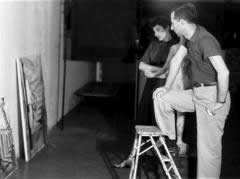
“It’s a place where, through the graphic arts mainly, and through all the others, the Aesthetic Realism point of view will be shown. I hope to show as clearly, as pointedly, as delightfully as possible that through paintings, sculpture, poetry, literature, the world makes great sense.”
And so the Terrain Gallery came to be. We see here Dorothy Koppelman and Sheldon Kranz looking at work for a show in the Terrain Gallery’s first home at 20 West 16th Street. This photo, and several more we’re about to see, were taken by Louis Dienes.
Since 1955, Exhibitions with a Basis
Since then there have been over 150 exhibitions, and Eli Siegel’s now historic Fifteen Questions, “Is Beauty the Making One of Opposites?” first published in the opening announcement of the gallery, have been the basis for selecting and exhibiting work. For example, there was the exhibition “Abstract/Concrete,” which showed together work of Ad Reinhardt, George Tooker—
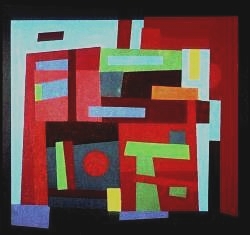
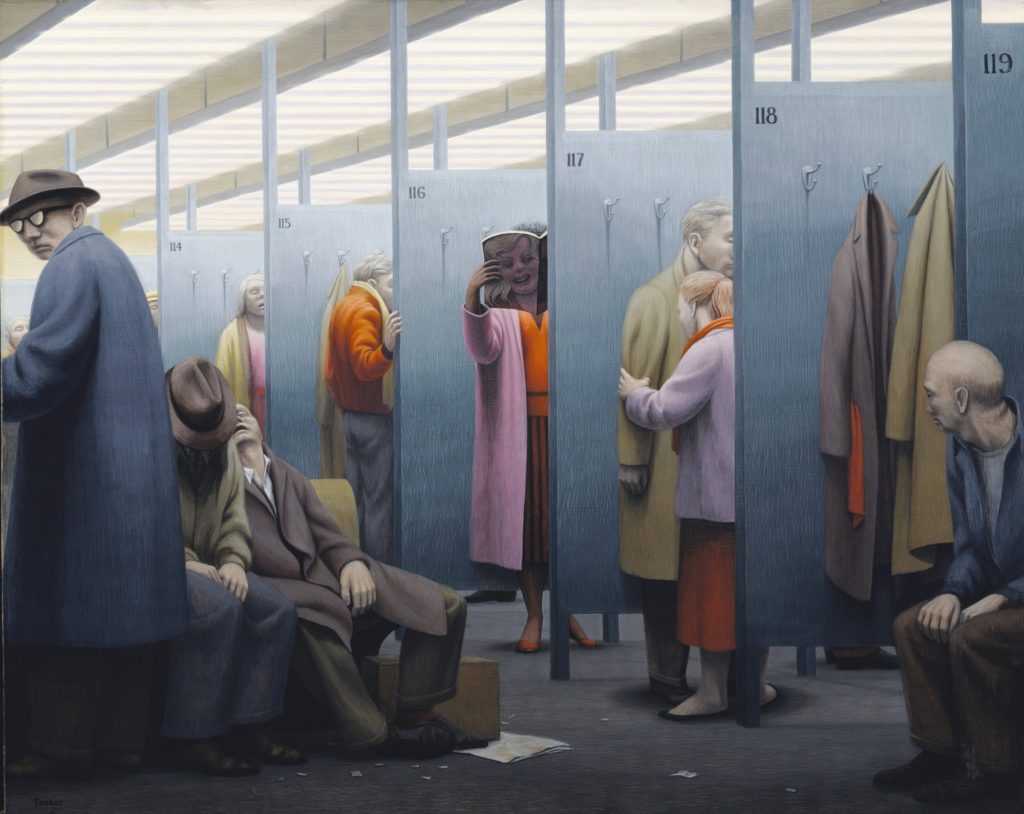
—and others, at a time when abstract and figurative art were seen generally as against each other, not, as this exhibition showed, as having something deep in common.
There was “The Shaping Mind: Sculpture,” an exhibition showing the friendliness of thought and the tangible, with work by 33 sculptors, including William King and George Sugarman:
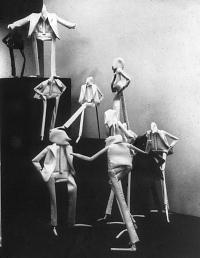
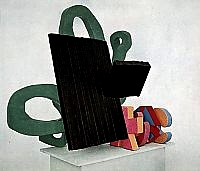
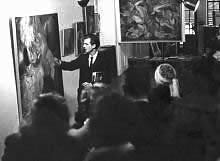
In 1955 the Terrain also began a series of talks by the Seurat Art Club, working artists who, as they said in the book We Have Been There, “found the Siegel Theory of Opposites to be exhilarating, technically alive…true to art as we have seen it.” Here, Chaim Koppelman gives a gallery talk:
And in December of that year, “Is Beauty the Making One of Opposites?” was reprinted in the Journal of Aesthetics and Art Criticism.
Writer Alice Bernstein has pointed out:
“The Terrain pioneered innovations in curating and displaying art that are taken for granted today….The New York Times noted: ‘The Terrain Gallery held one of the first exhibitions honoring photography as fine art…’ ”
—And when the gallery showed silkscreens as major works, Times critic Grace Glueck wrote, “The Terrain even had a whole show of them.” Yet in an article about the gallery by Alma Vincent, published in The Villager in 2000, she points out:
“While art critics praised early exhibitions in their reviews…[t]he one reviewer to write about the value of the Terrain’s point of view was Bennett Schiff, then art critic for a major New York newspaper. On June 16, 1957, reviewing…an exhibition of paintings and sculpture, he wrote: ‘There probably hasn’t been a gallery before this like the Terrain, which devotes itself to the integration of art with all of living according to an esthetic principle which is part of an entire, encompassing philosophic theory…Aesthetic Realism: The art of liking oneself through seeing the world, art, and oneself as the aesthetic oneness of opposites…the theory…developed by Eli Siegel…whose work has received growing recognition by such people as William Carlos Williams….It is a building, positive vision.’”
Bennett Schiff was certainly right.
1959 – 1960: Personal / Impersonal & The Real Show

In 1959, for the exhibition “Personal / Impersonal” celebrating the Terrain’s publication of the book of poems by Martha Baird, Sheldon Kranz, Louis Dienes, Nancy Starrels and others, artists such as Robert Andrew Parker, Leonard Baskin, and Nathan Cabot Hale showed works inspired by the poems.
“The Real Show” of 1960, was an exhibition with comment by the artists, among them, in this photo by Louis Dienes, are Bud Hopkins, Paul Waldman, Jack Sonenberg, and Chaim Koppelman on the left, and Dorothy Koppelman is with the white collar.
In 1964 the Terrain moved to 39 Grove Street. This is a photo by Andre Kertesz of Dorothy and Chaim Koppelman, seen through the screen of the front window, and his portrait of Dorothy Koppelman.
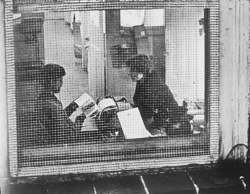
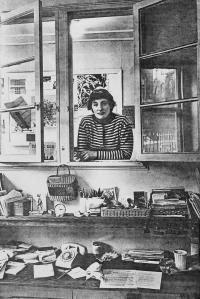
Print Shows Curated by Chaim Koppelman
In 1965 the exhibition “Above/Below” had work by 72 printmakers. Chaim Koppelman was the curator for this and many other print shows here. Among exhibiting artists were Will Barnet, Robert Conover, Nicholas Krushenick, Leonard Baskin, John von Wicht, Helen Frankenthaler, and Richard Artschwager—
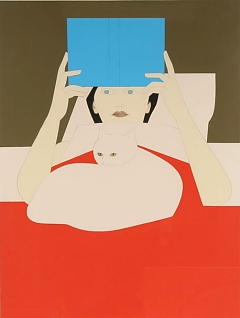
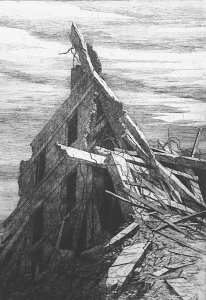
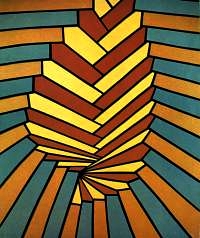
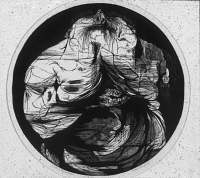
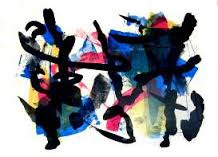
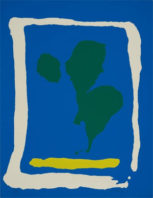
—to name only a few, and you will see works by some of these artists on the walls now.
The important all-silkscreen show referred to earlier, which took place that year, titled “Surface to Begin With,” with a striking poster designed by Arnold Schmidt, had work by Alex Katz, Roy Lichtenstein, Claes Oldenburg, Richard Anuszkiewicz, Elaine de Kooning, Fay Lansner, Malcolm Morley, Steve Poleskie, and many others.
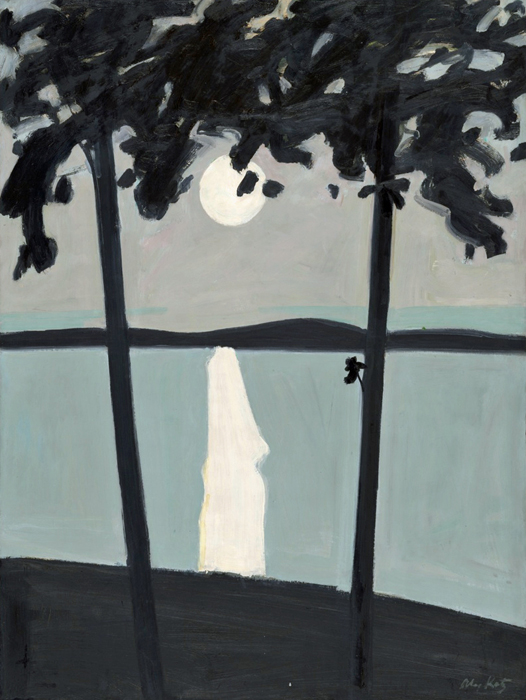
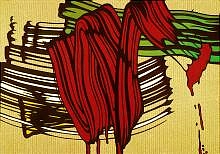
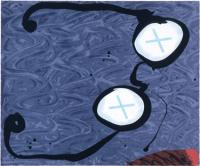
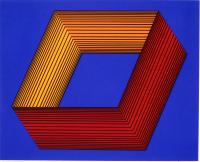
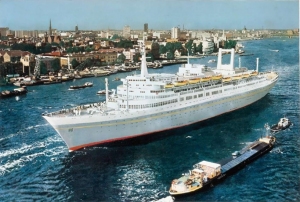
1967: “All Art Is For Life & Against the War in Vietnam”
In 1967, a benefit to aid napalm-burned children, “All Art Is For Life & Against the War in Vietnam,” had work by 100 artists. These installation shots were taken by David Bernstein.
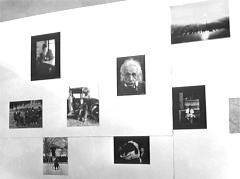
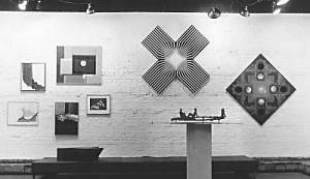
The democracy and integrity of the Terrain are two of the things for which it has long been respected. Its basis enabled works by well-known artists to be shown alongside works by those not yet known. And the work of women artists was richly represented, at a time when this was rare. Many artists had their first one-person shows at the Terrain—the Pop art of Richard Bernstein; the Optical paintings of Arnold Schmidt—
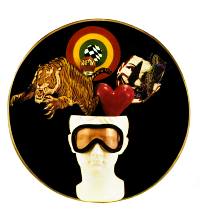
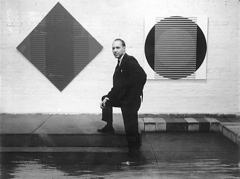
—after the first of his exhibitions, Schmidt’s work was in “The Responsive Eye” at the Museum of Modern Art. This photo of him is by Fred McDarrah of the Village Voice.
After the one-person shows of Dorothy Koppelman and Chaim Koppelman, both were chosen for MoMA’s 1962 exhibition “Recent Painting USA: The Figure.”
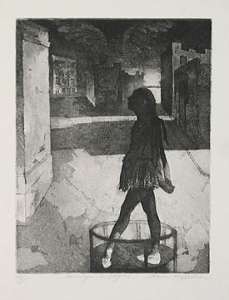
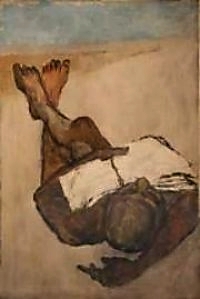
And there were the one-person shows of photographs by Louis Dienes, Nat Herz, and Nancy Starrels—
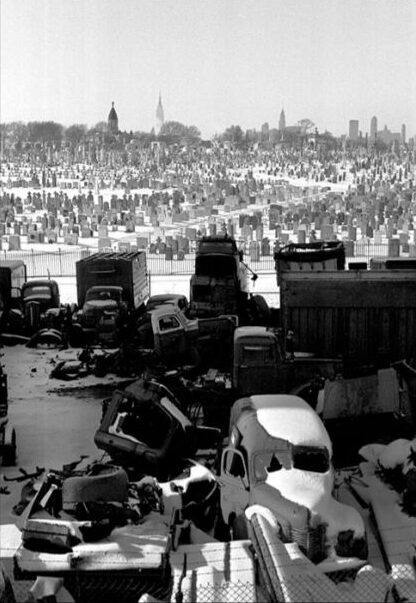
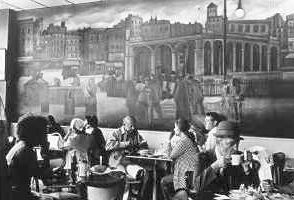
—and the drawings and silkscreens of Charles Magistro—one of the first shows at Greene Street.
Seeing Art’s True Value
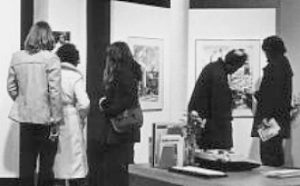
I’ll mention here, that it was in the fall of 1968 that I first came to the Terrain Gallery and read Eli Siegel’s 15 Questions about beauty. “That’s it!” I said. I’d found what I was looking for as I studied art history at Barnard, Harvard, and the University of Pennsylvania, and felt the frustration of not knowing how to be sure I wasn’t imposing myself on a work of art but was seeing its true value. And here were these questions through which I began to see the reason I’d loved art since I was a child. In 1972 I became a co-director of the Terrain Gallery.
In 1973 the Terrain became part of the Aesthetic Realism Foundation and moved to our present space.
Here is a photo taken at the opening of one of the eleven annual exhibitions of miniature works in all media, “Big & Small”; and on the right is a photograph by Lyle Light—I’m looking at miniature sculptures by Frank Motnyk:
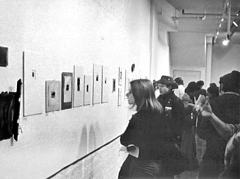
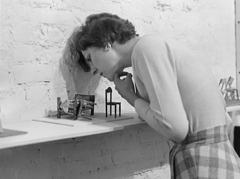
In the catalogue for these shows we stated,
“Art shows that nothing, however small, is without largeness and meaning. Art opposes everyday contempt—the desire to make things less in order secretly to enhance ourselves. In the art of the miniature you make things small and meaning becomes more.”
Other exhibitions, such as “The Arts, They’re Here!: Ten Arts and the Opposites,” showed the relation of works of many periods, styles, nationalities, and media—for example, Thick and Thin in Music:
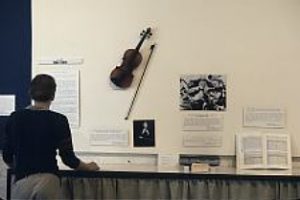
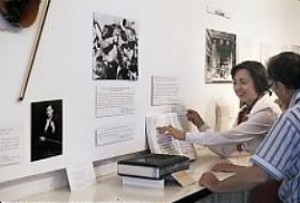
—on the right two persons on the teaching faculty of the Aesthetic Realism Foundation, music critic and poet Karen Van Outryve and geologist John Stern look at a score; Weight and Shape in Sculpture:
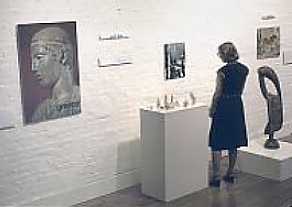
Jane Hall, now a Terrain Gallery Coordinator, stands near the head of the Charioteer of Delphi, and a Senufo bird—weight and shape are central in the sculpture of Ancient Greece and Africa.
And there were definitive exhibitions dedicated to one art, such as “Architecture: Matter & Space” including work by the first architects, the birds; the tools, beautiful in themselves, of builders—
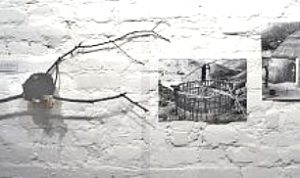

—the Woolworth Building; the work of Louis Sullivan, and much more.
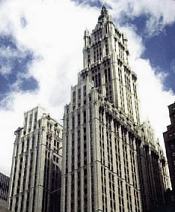
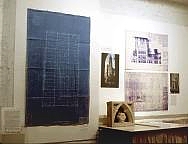
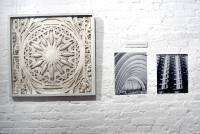
These installation photographs were taken by architect Anthony Romeo.
1984: Art Answers the Questions of Your Life!
In 1984, Chairman of Education Ellen Reiss suggested what became an exciting new aspect of the gallery’s history—the series of talks, Aesthetic Realism Shows How Art Answers the Questions of Your Life! new in art criticism. For example: “Can Exuberance Be Sensible?: Hans Hofmann’s ‘Rhapsody’” by Bennett Cooperman; “Logic and Emotion in Love and in the Shah Nameh” by Barbara Buehler; “What I Learned about Freedom & Order from St. Basil’s Cathedral” by David Salmon; and “What Can a Woman Learn about How to See Her Child from Mary Cassatt?” by Barbara McClung.
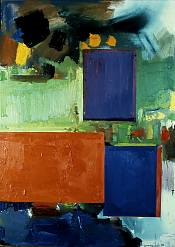
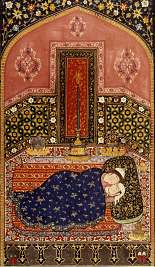
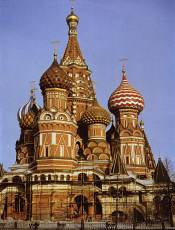
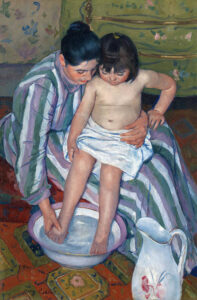
Now, after 50 years, the Terrain Gallery has lasted and is flourishing. These are photos from a recent opening: on the right, Chaim Koppelman and Marcia Rackow speak with Dr. Peter Gorlin, who interviewed Eli Siegel on WKCR.
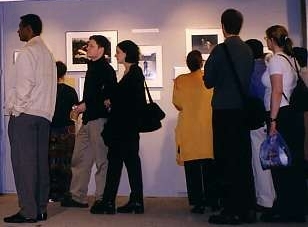
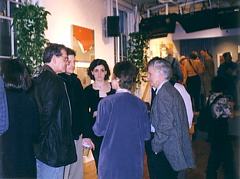
Original & Sincere Work
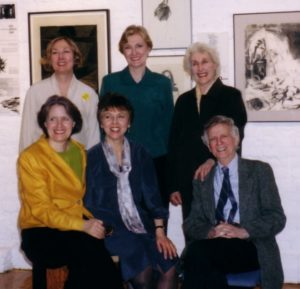
The Terrain has had a pervasive, though unacknowledged effect on 20th century art criticism, and we the Terrain Gallery Coordinating Committee—Dorothy Koppelman, Chaim Koppelman, Marcia Rackow, Nancy Huntting, Jane Hall, and myself, Carrie Wilson—celebrate and continue today this beautiful history of which many of you are a part.
The response of artists to the meaning of this anniversary show is important. It includes many who showed 30 and 40 years ago—such as Nancy Starrels, John Ross, Clare Romano, Mimi Gross, Al Blaustein, Edmond Cassarella, Rudy Burckhardt, Red Grooms, Selina Trieff, George Stadnik; artists who began showing more recenty—Richard Sloat, Su-Li Hung, Perry Hall, Gloria Rabinowitz, Stephen Fredericks, Allan Michael, Steven Stankiewicz, Michael Di Cerbo, Len Bernstein, Amy Dienes, Roseanne Backstedt; and artists whose work we’re showing for the first time—Robert Motherwell, Lois Dodd, Yvonne Jacquette, Tom Kranjac, Jeremy Comins. And in this great diversity of media, and styles, embracing some of the most original and sincere work of these decades, “the criterion,” as Dorothy Koppelman said last week, “blazes forth”: In reality opposites are one; art shows this.
Further resources:
Dorothy Koppelman: A Life of Art & Ethics, Journal of the Print World, 2018
Aesthetic Realism Shows How Art Answers the Questions of Your Life – 31st InSEA World Congress,Teachers College, Columbia University, NYC
“The World of Art” Interview of Eli Siegel by Peter Gorlin on WKCR-FM Columbia University Radio





